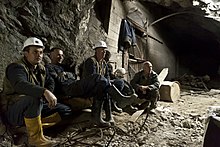Miner
This article needs additional citations for verification. (November 2012) |
| Occupation | |
|---|---|
Occupation type | Manual labour |
Activity sectors | Mining |
| Description | |
Fields of employment | Mining |


A miner is a person who extracts ore, coal, chalk, clay, or other minerals from the earth through mining. There are two senses in which the term is used. In its narrowest sense, a miner is someone who works at the rock face; cutting, blasting, or otherwise working and removing the rock.[1][2] In a broader sense, a "miner" is anyone working within a mine, not just a worker at the rock face.[1]
Mining is one of the most dangerous trades in the world.[3] In some countries, miners lack social guarantees and in case of injury may be left to cope without assistance.
In regions with a long mining tradition, many communities have developed cultural traditions and aspects specific to the various regions, in the forms of particular equipment, symbolism, music, and the like.
Roles[]
Different functions of the individual miner. Many of the roles are specific to a type of mining, such as coal mining. Roles considered to be "miners" in the narrower sense have included:
- Hewer (also known as "breaker" or "pickman"), whose job was to hew the rock.
- Collier, a hewer who hews coal with a pick.
- Driller, who works a rock drill to bore holes for placing dynamite or other explosives.
Other roles within mines that did not involve breaking rock (and thus fit the broader definition) have included:
- Loader (also called a "bandsman"), who loads the mining carts with coal at the face.
- Putter (also known as a "drags-man"), who works the carts around the mine.
- Barrow-man, who transported the broken coal from the face in wheelbarrows.
- Hurrier, who transported coal carts from a mine to the surface.
- Timbers, who fashions and installs timber supports to support the walls and ceiling in an underground mine.
In addition to miners working underground, a mine employs other workers in duties at the surface. In addition to the office staff of various sorts, these may include:
- Brakesman, who operate the winding engine.
- Breaker boy who breaks coal.
- Emergency Structure Engineer, who makes sure that cave-ins are dealt with when called
Modern miners[]

Mining engineers use the principles of math and science to develop economical solutions to technical problems for miners. In most cases, a bachelor's degree in engineering, mining engineering or geological engineering is required. Because technology is constantly changing, miners and mining engineers need to continue their education. [4]
The basics of mining engineering includes finding, extracting, and preparing minerals, metals and coal. These mined products are used for electric power generation and manufacturing industries. Mining engineers also supervise the construction of underground mine operations and create ways to transport the extracted minerals to processing plants.
Cryptocurrency miners[]
In cryptocurrency "mining", such as making bitcoins, a miner is a computer, or a cluster of computers, fabricating cryptocurrencies. They constantly verify transactions and as an incentive they get rewarded with cryptocurrencies. The process is very vorace in electrical energy, highly costly, and attracts the greed of many people like in a gold rush. Cryptocurrencies are rare and expensive such as gold and generate many financial speculation. From there, it is often compared to "gold mining".
Gallery[]

A brown coal miner with a pickaxe. West Germany, 1952

Miner in a mine of the "Cerro Rico" at Potosí, Bolivia, 2006

Miner spraying rockdust in a mine in West Virginia, 2009

Coal Miner's Memorial in Mursko Središće, Croatia

Sunshine Miners Memorial in Silver Valley, Idaho
See also[]
- Amateur geology
- Mineral collecting
- Miner's apron
- Miner's cap
- Miner's habit
- Mining helmet
- Mooskappe, miner's cap worn in the Harz
- Prospecting
- Salt mining
- Underground mining (hard rock)
Distinguish from[]
- Minor (disambiguation)
References[]
| Wikimedia Commons has media related to Miners. |
- ^ Jump up to: a b Hill, Albert H. (1920). "miner". A Glossary of the Mining and Mineral Industry. Washington D.C.: United States Department of the Interior, Bureau of Mines.
- ^ Raymond, R.W. (1881). "miner". A Glossary of Mining and Metallurgical Terms. Easton, Pa.: American Institute of Mining Engineers.
- ^ "Mining: The Most Dangerous Job? - ABC News". Abcnews.go.com. 2010-04-06. Retrieved 2016-04-06.
- ^ "Mining and Geological Engineers : Occupational Outlook Handbook: : U.S. Bureau of Labor Statistics". www.bls.gov. Retrieved 19 March 2018.
- Mining
- Miners
- Gendered occupations
- Resource extraction occupations




